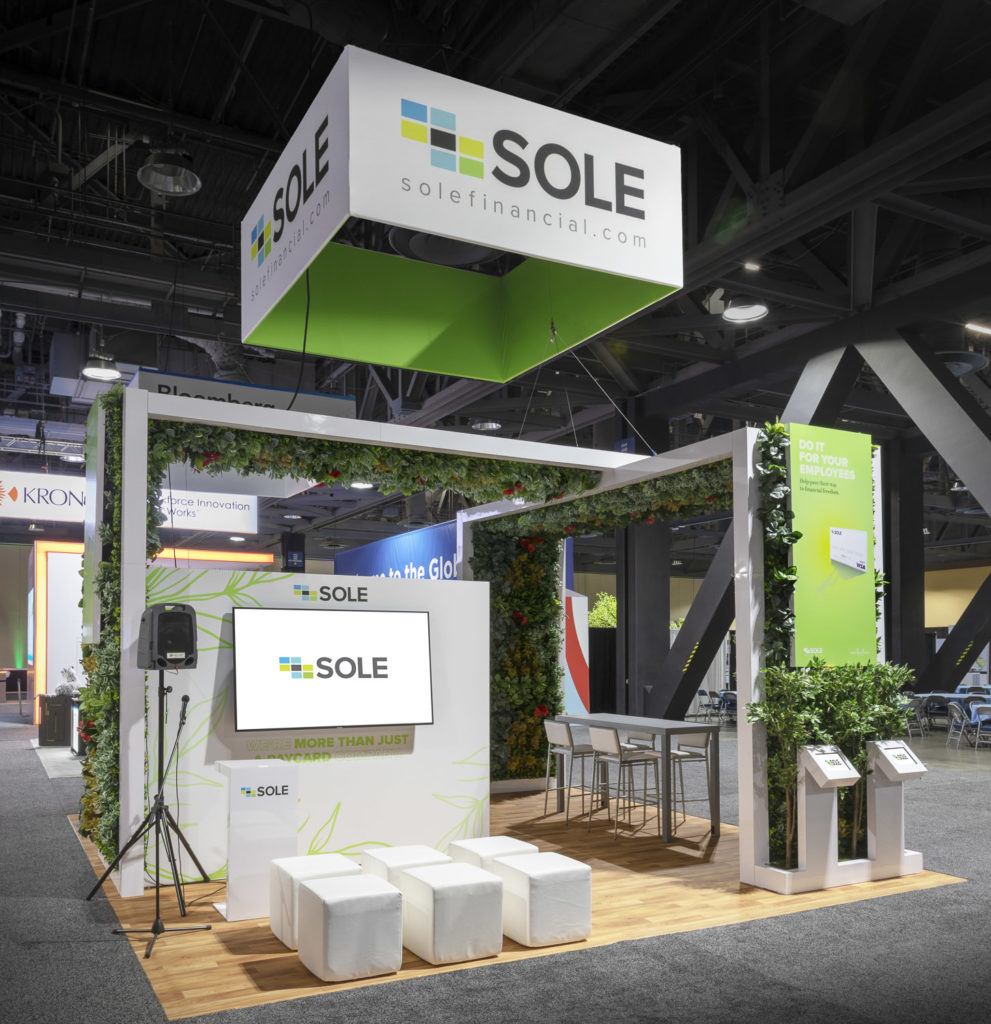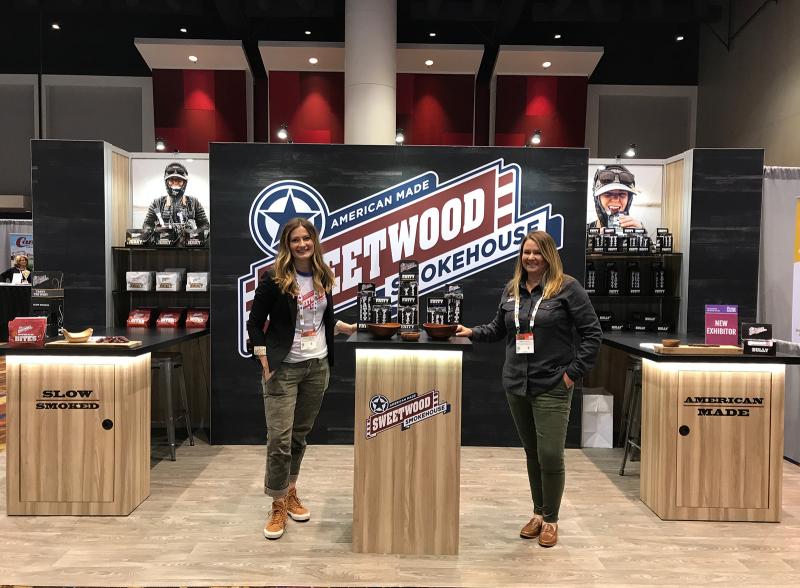You want and deserve a beautiful custom exhibit design. That takes time, even if you’re starting with a pre-configured design. Smart exhibitors start the trade show exhibit design process early. They meet with the stakeholders to identify the goals, messaging, and budget and then assign tasks and deadlines.
Planning is crucial because trade shows are set well in advance, and those dates don’t change. The show will start on the assigned date whether or not your booth arrives. If you’ve ever attended a trade show, you’ve seen an empty booth space where an exhibitor didn’t arrive on time. They paid for the space AND they lost any potential sales. That’s unfortunate. While that doesn’t happen very often, avoidable delays are very common. Procrastination often adds 2 to 3 times the final price and increases the likelihood of mistakes. So…. how do you avoid those issues? Let’s begin at the beginning with your trade show exhibit design.
Exhibit Design 101
At Exhibits NW, we know the best way to avoid costly mistakes and marketing miscues is to have an open conversation with your exhibition lead designer and your team. The meeting can start with a general summary of your goals and budget, which may include a conversation about what’s worked (and hasn’t worked) with previous exhibit designs. This early meeting will set the stage for a more detailed review to follow. Two things are critical during this second meeting:
#1. Review and answer the 15 questions below. Answering the questions establishes a design foundation and provides a framework for future conversations. Which questions are the most important changes on a case-by-case basis so the order isn’t important. Feel free to add additional questions and answers if the ones below don’t allow you to fully explain your goals, branding, and requirements.
#2. Have the right people at the meeting or if that’s not possible, have them assist with answering the 15 questions. Nothing is more frustrating than completing the exhibit and graphic design ONLY TO DISCOVER that the decision-maker isn’t on board. That should never ever happen. Not only is it a waste of time but it’s also an expensive one. Plus, it delays the entire process.

15 Questions to Ask During Your Trade Show Exhibit Design Process
Exhibit Design Questions 1-5
1. Does your company have branding guidelines/logo or graphic files/website address? Can you share these files?
2. What size is the exhibit? Do you plan to reconfigure the exhibit for other shows? If so, what sizes? Knowing this will guide both the design and the choice of materials.
3. What is the budget? This is essential. Still undecided about an exact budget? The next best option is a workable budget range. No exhibitor wants to be surprised with a beautiful booth outside their budget or underwhelmed by a booth designed for a lower budget.
4. Do you want to purchase or rent? Or a combination of both? This assists the designer in choosing material and designing for a specific budget.
5. What physical properties does the exhibit need to have? For example, workstations, counters, slatwall, semi-private or private conference area, monitors, storage, etc.? This information allows the designer to create a functional trade show design.
Exhibit Design Questions 6-10
6. What type of display have you used in the past? Are you looking for something similar or different? What did you like or not like about the previous booth?
7. Are there any materials or construction methods you prefer? Are you looking for something similar or different? Many experienced exhibitors have a strong attraction or aversion to specific materials.
8. Are there any unusual dimensional restrictions? Can you provide show regulations? Some shows have unusual restrictions for the height of the booth or setbacks from the aisle.
9. Do you show product(s)? What are the dimensions and specifications? How do you prefer to show the products? Display cases, countertop, shelves, hooks, etc.?
10. Does the display need to be portable or modular? Does it need to ship via FedEx or UPS or are you OK with packing in custom crates? This will guide our use of materials.
Exhibit Design Questions 11-15
11. Who will assemble the display: show labor or your own team? We have great solutions for both scenarios.
12. Do you have any images of the design elements you like? Even if these “inspiration images” are not trade show related, they are very helpful. For example, architectural elements, finishes, colors, natural elements, retail environments, etc.
13. Design Due Date? Typically, designs are completed within a few business days. However, every project and every client has their own timeline. We do our best to accommodate the requested timelines.
14. Show Opening Date? So very important! Creating the design and them building it depends on the time frame. Designers can make material selections that will go a long way toward meeting a three-week vs. a three-month window.
15. Are there any descriptive words you use to describe your company? What do you want visitors to your booth to “feel” about your company? From “opulent” to “bad-ass,” we have heard some interesting descriptors, and this gives the designer the insight to craft a personalized, experiential space.

Red Flags to Avoid with Trade Show Booth Design Companies
There are no consumer reports for trade show booth design companies. No Yelp or Trip Advisor. Even Google Reviews are not very helpful. So how do you decide on a design company?
Size and Budget
Small displays meant for exhibitors with modest budgets are widely available on portable exhibit websites. Prices and quality can vary considerably. If you are unfamiliar with trade shows or displays, consult a local professional, if possible. It won’t cost you more. Plus, you’ll tap into loads of experience in the trade show industry. Not knowing is the #1 mistake most exhibitors make.
Capabilities and Clients
There are HUGE exhibit houses. REGIONAL exhibits houses. Exhibit houses that specialize in rentals. Some target specific industries like pharmaceuticals, gaming, or automotive. Not every exhibit house has the same build capabilities or technical expertise. Choosing the right exhibit house for your booth design is like interviewing a potential employee. Review their website (resumé), conduct interviews, and check their references (existing clients). Also, ask industry colleagues for advice.
Small Fish. Big Pond
While your trade show budget may not be Sony, GM, or Boeing big, that doesn’t mean your exhibit marketing program isn’t important. You want your exhibit house to care about your trade show program. Which means they care about not only what you buy but also if your trade show marketing program is successful. That can be challenging since you want a provider that has all the capabilities you need and the personalized services that will make your job easier and your trade show program successful.
Location. Location. Location.
Sometimes location matters. Sometimes it doesn’t. Distance isn’t as critical as it used to be. Booth design can be done virtually as long as the right people are participating.
People and Culture
It always comes down to people and culture. Do you like them? Do they share your values? Are they responsive? When things go wrong, do they solve the problem or blame others?
Exhibition Booth Design Professionals
Over the years, we’ve been assisting thousands of clients on a wide range of design projects including store design, fixtures, displays, and events. Not surprisingly… every single one began with a casual conversation.
At Exhibits NW, we specialize in designing and building captivating 3D structures for events, retail, and trade shows. Give us a call today to see how we can help you inspire and reinvent your retail business.
